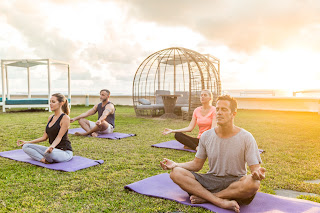Introduction To Yoga.
In the hustle and bustle of our modern lives, finding a sense of balance and inner peace can feel like an elusive quest. However, there is a practice that has been helping individuals around the world achieve just that - yoga. Beyond the physical postures, yoga offers a holistic approach to wellness, nurturing the mind, body, and spirit. In this article, we will delve into the transformative power of yoga , exploring how it can help you find balance, tap into your inner strength, and cultivate a deep sense of inner peace.
Finding Balance: Yoga is a journey that begins with finding balance, both on and off the mat. Through a series of postures, known as asanas, yoga encourages us to develop strength, flexibility, and stability in our bodies. By practicing balance poses like Tree Pose or Eagle Pose, we not only improve physical equilibrium but also enhance our ability to find harmony in life's challenges . Yoga teaches us to bring awareness to our breath and movements, fostering a sense of poise and centeredness that extends far beyond the yoga studio.
Harnessing Power: Beyond its physical benefits , yoga empowers us to tap into our inner strength. Through regular practice, we cultivate resilience, perseverance, and a deeper connection with our bodies. Yoga challenges us to explore our limits and step outside of our comfort zones, ultimately expanding our capabilities. As we flow through sequences such as Sun Salutations or practice inversions like Headstand, we not only build physical strength but also cultivate mental and emotional fortitude. Yoga reminds us that true power lies within, waiting to be harnessed and unleashed.
Discovering Inner Peace: In our fast-paced world , inner peace may seem like an elusive dream. Yet, yoga provides a pathway to discovering a profound sense of tranquility within ourselves. Through mindful breathing, meditation, and relaxation techniques, yoga helps us quiet the mind, release tension, and find solace in the present moment. With regular practice, we develop a heightened awareness of our thoughts and emotions, allowing us to respond to life's challenges with greater equanimity. Yoga becomes a sanctuary, a space where we can cultivate inner peace that permeates every aspect of our lives.
some questions which comes in mind related to yoga are as follows-
- What is the purpose of yoga?
- Improved flexibility and range of motion.
- Increased strength and muscle tone.
- Enhanced balance and stability.
- Better posture and alignment.
- Increased energy and vitality .
- Enhanced cardiovascular health (with dynamic forms of yoga).
- Stress reduction and relaxation.
- Support for healthy weight management.
- These physical benefits of yoga contribute to overall well-being and can help you lead a healthier and more active lifestyle.
- Yoga practice for finding balance , power, and inner peace
- Inner peace through yoga practice
- Enhancing the mind- body connection with yoga
- Building strength and flexibility through yoga practice
- Discovering balance through yoga postures
- Breath control and inner peace in yoga (pranayama)
- Meditation and mindfulness for inner peace in yoga
- Exploring self-discovery through yoga practice
- Yoga for overall well-being and inner peace
- Harmonizing body and mind through yoga practice
- Relaxation and inner peace with yoga
- Tapping into the power within through yoga
- Cultivating inner strength with yoga practice
- Yoga for inner peace and serenity
- Achieving inner peace through the practice of yoga



